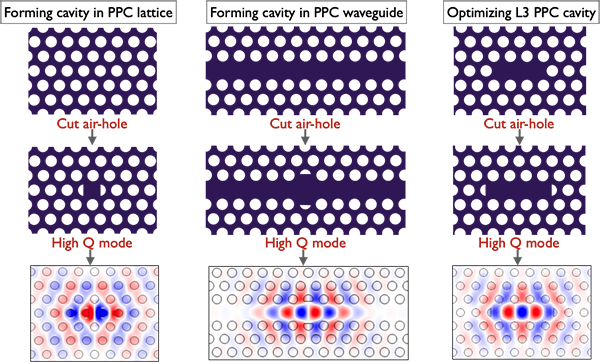As one of the most important optical resonators, the photonic crystal cavity has a variety of advantages to resonantly control light-matter interactions and light wave propagations. First, the photonic crystal cavity is well recognized as one of the optical cavities with the highest Q/Vmode factor, where Q and Vmode are quality factor and mode volume of the resonant mode, respectively. The density of electric field of a resonant mode is proportional to the Q/Vmode factor, which therefore enables the photonic crystal cavitie as a promising platform to control light-matter interactions for highly efficient nonlinear optics, optomechanics, classical and quantum light emissions. Second, photonic crystal cavities are normally fabricated in dielectric slabs, including silicon, silicon nitride, III-V groups, and lithium niobate. Their planar structures make them easy to construct ultracompact photonic integrated circuits with the combination of other defect structures in the planar photonic crystal (PPC), such as PPC waveguides. The planar structure also allows their integration with electrical circuits for optoelectronic devices. Third, compared with other optical cavities, these PPC cavities could be straightforwardly fabricated using the standard technologies of semiconductor electronic devices, facilitating their practical applications.
In the past decades, a number of designs have been reported to realize PPC cavities with high Q factor and small Vmode. PPCs are normally periodic air-holes with a triangular lattice in a dielectric slab. If structure-defects were involved into the PPC lattice, defect modes could originate inside the PPC's photonic bandgap, forming a PPC cavity. Summarized from the previously reported PPC cavities, missing air-holes and moving air-holes in PPCs are two of the most widely accepted defect-designs, including the popular types of L3, H0, heterostructure, and local width-modulation.
The research group led by Prof. Jianlin Zhao from Northwestern Polytechnical University proposed that simply cutting air-holes in PPC to semicircles could be considered as a new strategy to form and optimize PPC cavities. The research results are published in Chinese Optics Letters, Vol. 18, Issue 6, 2020 (Liang Fang, Xuetao Gan, Jianlin Zhao. High-Q factor photonic crystal cavities with cut air holes [Invited][J]. Chinese Optics Letters, 2020, 18(6): 063603).
Three examples of realizing and optimizing PPC cavities using cut air-holes were described. In the formations of PPC cavities, by simply cutting two adjacent air-holes in a PPC lattice or two air-holes on the opposite sides of a PPC waveguide, resonant mode with Q factor exceeding 105 are obtained. In the optimization of PPC cavity, by cutting the two air-holes at the edge of a L3-type cavity, the Q factor is optimized by more than 20 times, while Vmode is almost constant. Results of these three examples also indicate that the cavities with cut air-holes have superiorities over cavities with missed or moved air-holes in the higher Q factor and smaller Vmode.
"In the photonic crystal cavities with missed or moved air-holes, the air-holes around the cavity edges have circularly shapes. By contrast, in our proposed cavities, the cut air-holes have flat sides facing to the strong mode distribution, which could relax the impedance mismatch at the interfaces of air-holes and the dielectric slab much more. It therefore enables much gentler mode confinement in the cavities. This is why the strategy of cut air-holes could promise advantages in designing and optimizing cavities." says the corresponding author Prof. Jianlin Zhao from the research group. "Actually, in our group, we are also pursuing to reveal whether this concept of cut air-holes could be employed in designing photonic crystal waveguides with engineered transmission loss and dispersion, which is another important defect structure in PPCs."

Forming and optimizing photonic crystal cavities by cutting air-holes into semicircles


